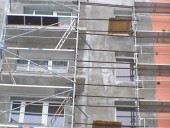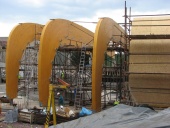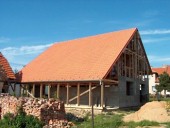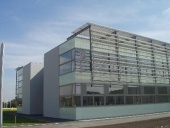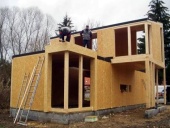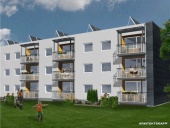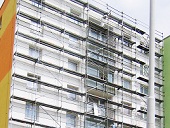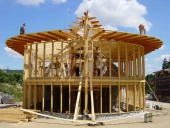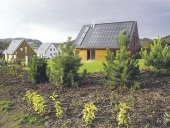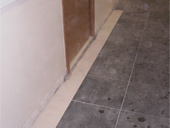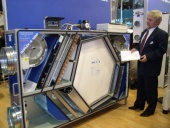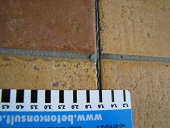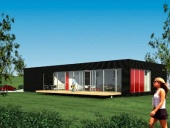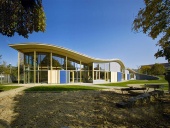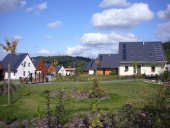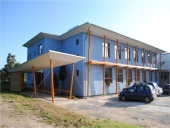The paper is contribution to the topic of reconstruction and revitalisation of panel buildings. In two examples possible solution of replacement of steel railing of loggia by masonry railing in a panel system T08B is shown.
Archiv článků od 24.1.2011 do 11.4.2011
The paper is focused on some new types of timber structures made from solid timber, glued laminated timber and wood based materials. Especially glued laminated timber is a highly engineered material, because large sizes of structural members and the possibility of various shapes in beams, frames and arches are available. The analysis of intensive loaded structures with large spans shows clearly that to the most advantageous types of connections belong those made by means of steel elements. The analysis of the slip of joints and supports ranks among important issues in designing timber structures. The paper summarises some experience and conclusions from the construction of timber systems with steel-to-timber joints.
In 2007 the group GAIA SpA got an idea from Massimo Fiorini (an amateur builder) to reconstruct the delapidated Marconi Laboratories in Coltrano, near Pisa (Italy) and turn it into EneryPlus terraced passive houses. The group was fully convinced after a visit to the ASSA passive office building in Santa Croce Sull'Arno, and in 2008 they began the design works. The building turned out to be appropriate to be turned into a passive house project. However, the problem was listed in the highest heritage class, which had been granted not for the importance of the building itself, but as part of a listed group. The planning had to be very detailed. Another problem was the arched concrete roof, which was extremely vulnerable to collapse. The Heritage Protection Office in Pisa was at first very sceptical with the project, but in the end they were convinced about the interest and the quality of the project after a series of meetings with the builders and the representatives of TBZ.
There’s still big potential to make building cheaper, including building of passive houses. If the passive house building is optimalised and uncomplicated, It can be much cheaper than classic building. This paper analyses the building of family passive house in the Czech Republic step by step by the author himself.
Currently, in the EU, the demand for new organic materials based on rapidly renewable natural sources is increasing. These materials are not only used for the new low energy and passive buildings, but also in existing buildings, specially during their renovations. Unlike those commonly used today, these natural materials have acoustic insulation properties, which make them ideal to be used on the insulation of floating floors. The paper deals with a comprehensive assessment of the insulation properties of hemp based materials, which can be used in floating floors, specially in terms of their acoustic insulation properties and also in terms of the total utility properties of these floating floors.
Over 5000 buildings in Austria have been constructed in the passive standard. In the future, a considerable part of new constructions should be build in the passive standard. The goal is to have all subsidised residential buildings built in the passive standard by 2015. The aim of the study was to learn from the first residential complexes of passive buildings. The main questions were: Do the passive buildings meet the ambitious expetations of the project? How satisfied are the people living in them? What additional construction costs can be expected and what are the actual energy savings compared to conventional residential complexes?
As in other countries, in Norway energy remediation is carried out mostly on an average level. For a decade, this has blocked highly effective energy saving measures in public housing because better energy remediation measures pay off only after a long time. Myhrerenga is the first block of flats in Norway renovated according a passive house concept.
Low energy (LEB) and passive buildings (PB) are becoming standard for new constructions in EU countries. They aren't experiments anymore, but absolutely ordinary mass production of sophisticated residential buildings. Only in Germany, Austria and Switzerland there are already thousands of buildings that meet the passive standard and their number doubles every year. The cost of passive buildings is only 5-7 % higher than those of conventional ones, and yet, their consumption of energy and heating is up to 90 % lower! Part 4 about circulation system air heating system with a controlled proportion of ventilation air and heat recovery, and some design principles for design and ventilation NED EPD.
The article describes some of the results of the research project R&D SP3g522107 – Full renovation of panel buildings in the low energy standard, which was carried out by EkoWATT with the support of the Ministry of the Environment in the years 2007-2010. One of the main instruments described is the parametric model, which allows the evaluation of a large sample of virtually generated building probabilistic methods, a case study of a renovation of a panel building to a passive standard using a grant with a 8 year investment return and also, an internet application that easily allows to add a panel building to a computer model and test the effects of the saving measures.
Development of buildings with wooden structures in the Czech Republic relates to development of low-energy buildings. But there is still general public that is affraid of these constructions because of the fire danger. It is seldom known that wood is fire resistant very well, especially in the point of wiev the static resistance and solidity. In case of fire, in contrast to steel, wood does not lose its static resistance and solidity. The rest of a profile is usualy still able to care the waighting.
Low energy (LEB) and passive buildings (PB) are becoming standard for new constructions in EU countries. They aren't experiments anymore, but absolutely ordinary mass production of sophisticated residential buildings. Only in Germany, Austria and Switzerland there are already thousands of buildings that meet the passive standard and their number doubles every year. The cost of passive buildings is only 5-7 % higher than those of conventional ones, and yet, their consumption of energy and heating is up to 90 % lower! Part 3 about ventilation systems for normal buildinghs and EPD.
Unfortunately, the issue of impact noise transfer between floors is still sidelined. The trasnfer of impact noises can happen between directly neighbouring areas and also between spaces separated by other rooms. The solution to this can be very expensive and in some cases, difficult to carry out (e.g. floors connected by stairways or elevator shafts). It is therefore advisable to consult someone with expertise in acoustics during the design phase.
Czech method for building quality classification SBToolCZ and the first certificated building X-LOFT
One of the way how to recognize quality of buildings are methods for sustainable buildings classification. SBToolCZ is a certification method for complex building quality classification according to sustainable buildings principles – including environmental, social and economic criterions. The SBToolCZ method is based on the international SBTool system. Criterions and requirements are being modified according to standards development on the international level. SBToolCZ was developed on Faculty of civil engineering (Czech Technical University Prague), CIDEAS centre.
Low energy (LEB) and passive buildings (PB) are becoming standard for new constructions in EU countries. They aren't experiments anymore, but absolutely ordinary mass production of sophisticated residential buildings. Only in Germany, Austria and Switzerland there are already thousands of buildings that meet the passive standard and their number doubles every year. The cost of passive buildings is only 5-7 % higher than those of conventional ones, and yet, their consumption of energy and heating is up to 90 % lower! Part 2. about regulation ventilation system.
The paper focuses on explaining the causes of defects in ceramic materials that were applied in a seemingly stable substructure or layer. It brings attention to volume changes and also to elastic and plastic deformations of reinforce concrete floor structures, which can cause enough stress in surface layers consisting of tiles to lead to cracking or delamination. The examples show how and under what conditions these defects are manifested.
Subsidy programs to promote the reduction of energy consumption and to increase the use of renewable energy sources are available not only in the Czech Republic but also in our neighbouring countries. Let's have a look at the possibilities of financial support are available in Germany field of energy efficiency and renewable energy sources.
Low energy (LEB) and passive buildings (PB) are becoming standard for new constructions in EU countries. They aren't experiments anymore, but absolutely ordinary mass production of sophisticated residential buildings. Only in Germany, Austria and Switzerland there are already thousands of buildings that meet the passive standard and their number doubles every year. The cost of passive buildings is only 5-7 % higher than those of conventional ones, and yet, their consumption of energy and heating is up to 90 % lower!
In 2007 we worked on the design for a energy passive construction for the nursery and gyms in Slivenec and a proposal to link the entire complex, where the nursery and the gym would be part of the already existing school site. A building permit was issued at the time for the completion and renovation of one of the pavilions of the elementary school. Within our design, we considered the completion of this pavilion and we included it in the architectural study of the whole design. Even though we were not counting on it, in the end, we got the first commission to revise the project for the completion and reconstruction of this pavilion, so it would become an energy efficient building according to our architectural modifications.
zpět na aktuální články
